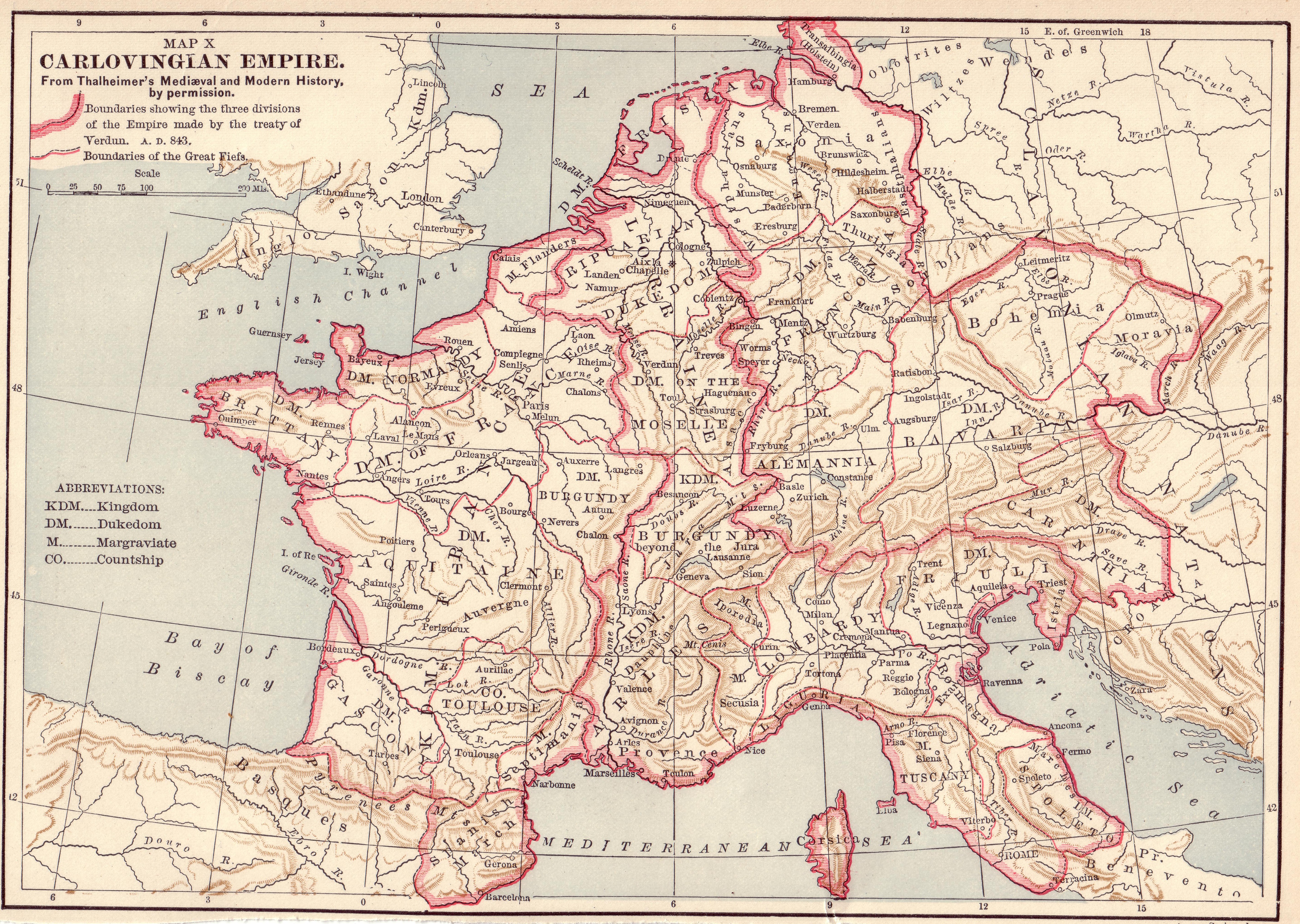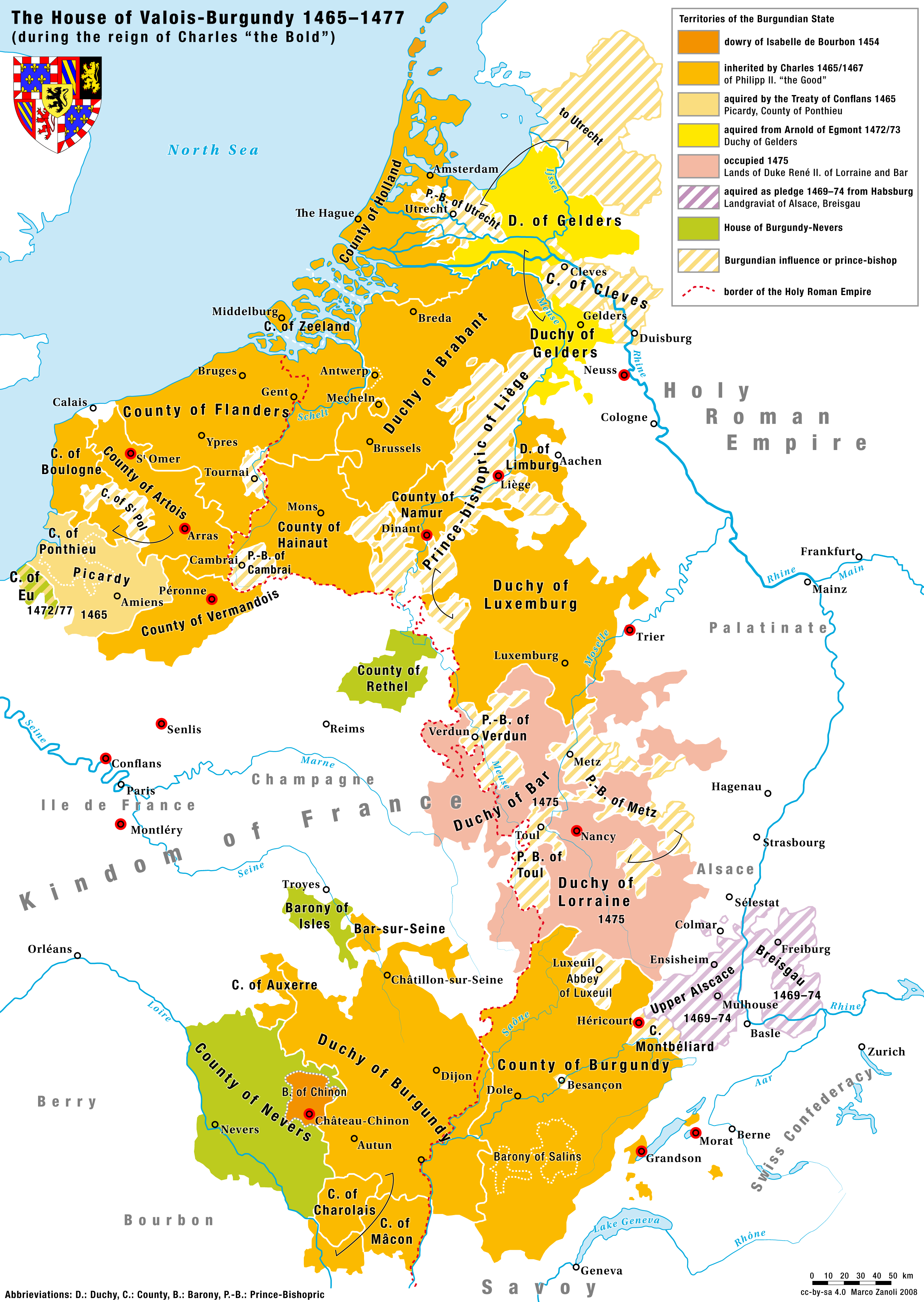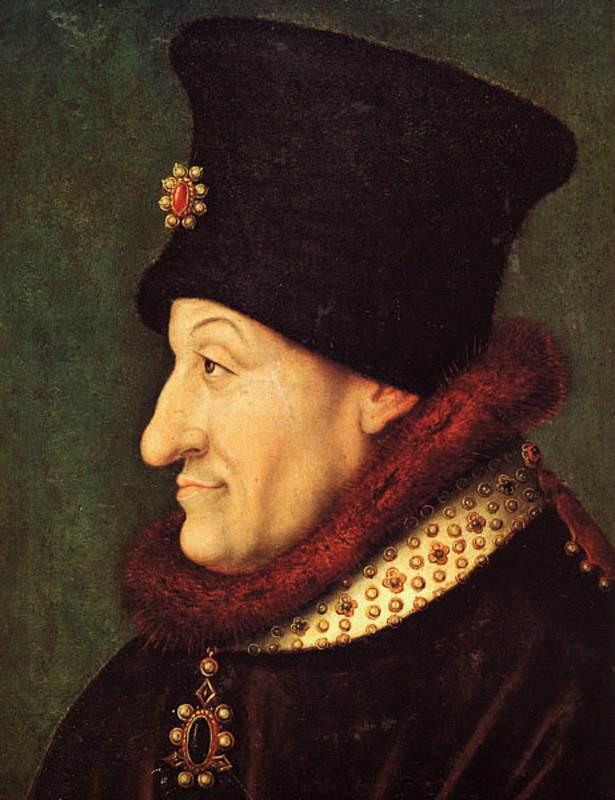|
Duke Of Burgundy
Duke of Burgundy (french: duc de Bourgogne) was a title used by the rulers of the Duchy of Burgundy, from its establishment in 843 to its annexation by France in 1477, and later by Holy Roman Emperors and Kings of Spain from the House of Habsburg who claimed Burgundy proper and ruled the Burgundian inheritance in the Low Countries. The Duchy of Burgundy was a small portion of the traditional lands of the Burgundians west of the river Saône which, in 843, was allotted to Charles the Bald's kingdom of West Franks. Under the Ancien Régime, the Duke of Burgundy was the premier lay peer of the kingdom of France. Beginning with Robert II of France, the title was held by the Capetians, the French royal family. It was granted to Robert's younger son, Robert, who founded the House of Burgundy. When the senior line of the House of Burgundy became extinct, it was inherited by John II of France through proximity of blood. John granted the duchy to his younger son, Philip the Bold. The ... [...More Info...] [...Related Items...] OR: [Wikipedia] [Google] [Baidu] |
Crown Of A Duke Of France
A crown is a traditional form of head adornment, or hat, worn by monarchs as a symbol of their power and dignity. A crown is often, by extension, a symbol of the monarch's government or items endorsed by it. The word itself is used, particularly in Commonwealth countries, as an abstract name for the monarchy itself, as distinct from the individual who inhabits it (that is, ''The Crown''). A specific type of crown (or coronet for lower ranks of peerage) is employed in heraldry under strict rules. Indeed, some monarchies never had a physical crown, just a heraldic representation, as in the constitutional kingdom of Belgium, where no coronation ever took place; the royal installation is done by a solemn oath in parliament, wearing a military uniform: the King is not acknowledged as by divine right, but assumes the only hereditary public office in the service of the law; so he in turn will swear in all members of "his" federal government''. Variations * Costume headgear imitati ... [...More Info...] [...Related Items...] OR: [Wikipedia] [Google] [Baidu] |
West Franks
In medieval history, West Francia (Medieval Latin: ) or the Kingdom of the West Franks () refers to the western part of the Frankish Empire established by Charlemagne. It represents the earliest stage of the Kingdom of France, lasting from about 840 until 987. West Francia emerged from the partition of the Carolingian Empire in 843 under the Treaty of Verdun following the death of Charlemagne's son, Louis the Pious. It is considered the first polity in French history. West Francia extended further north and south than modern metropolitan France, but it did not extend as far east. It did not include such future French holdings as Lorraine, the County and Kingdom of Burgundy (the duchy was already a part of West Francia), Alsace and Provence in the east and southeast for example. It also did not include the Brittany peninsula in the west. In addition, by the 10th century the authority of the West Frankish monarchs was greatly reduced. This was contrasted by the evergrowing power of ... [...More Info...] [...Related Items...] OR: [Wikipedia] [Google] [Baidu] |
Kingdom Of Provence
The Kingdom of Lower Burgundy, or Cisjurane Burgundy, was a historical kingdom in what is now southeastern France, so-called because it was lower down the Rhône Valley than Upper Burgundy. It included some of the territory of the Kingdom of Arelat. The borders of Lower Burgundy were the Mediterranean Sea to the south, Septimania to the southwest, Aquitaine to the west, the Kingdom of Upper Burgundy to the north, and the Kingdom of Italy to the east. History The West Frankish King Louis the Stammerer died on 10 April 879 and was survived by two adult sons, Louis and Carloman. Boso, Count of Vienne, renounced allegiance to both brothers and in July claimed independence of the Kingdom of Provence. On 15 October 879, the bishops and nobles of the region around the rivers Rhône and Saône assembled in the Synod of Mantaille and elected Boso king as successor to Louis the Stammerer, the first non-Carolingian king in Western Europe in more than a century. This was th ... [...More Info...] [...Related Items...] OR: [Wikipedia] [Google] [Baidu] |
House Of Ardennes
The House of Ardenne (or Ardennes, French ''Maison d'Ardenne'') was an important medieval noble family from Lotharingia, known from at least the tenth century. They had several important branches, descended from several brothers:Parisse, ‘Généalogie de la Maison d'Ardenne’, La maison d'Ardenne Xe-XIe siècles. Actes des Journées Lotharingiennes, 24 - 26 oct. 1980, Centre Univ., Luxembourg, (1981) 9-41 *The House of Ardenne–Verdun, with several Dukes of Lower Lotharingia, descended from Count Gozelin. *The House of Ardenne–Bar, with several Dukes of Upper Lotharingia The Duchy of Lorraine (french: Lorraine ; german: Lothringen ), originally Upper Lorraine, was a duchy now included in the larger present-day region of Lorraine in northeastern France. Its capital was Nancy. It was founded in 959 following th ..., descended from Frederick I, Duke of Upper Lorraine. *The House of Ardenne–Luxembourg, descended from Count Sigfried. All members descended from Cu ... [...More Info...] [...Related Items...] OR: [Wikipedia] [Google] [Baidu] |
Courtesy Title
A courtesy title is a title that does not have legal significance but rather is used through custom or courtesy, particularly, in the context of nobility, the titles used by children of members of the nobility (cf. substantive title). In some contexts, ''courtesy title'' is used to mean the more general concept of a title or honorific such as Mr., Mrs., Ms., Dr., Miss, Sir, and Madam. Europe In Europe, including France, many titles are not substantive titles but remain ''titres de courtoisie'', and, as such, are adopted unilaterally. When done by a genuine member of the '' noblesse d'épée'' the custom was tolerated in French society. A common practice is ''title declension'', when cadet males of noble families, especially landed aristocracy, may assume a lower courtesy title than that legally borne by the head of their family, even though lacking a titled '' seigneury'' themselves. For example, the eldest son of the ''Duke of Paris'' (substantive title) may be called ' ... [...More Info...] [...Related Items...] OR: [Wikipedia] [Google] [Baidu] |
House Of Bourbon
The House of Bourbon (, also ; ) is a European dynasty of French origin, a branch of the Capetian dynasty, the royal House of France. Bourbon kings first ruled France and Navarre in the 16th century. By the 18th century, members of the Spanish Bourbon dynasty held thrones in Spain, Naples, Sicily, and Parma. Spain and Luxembourg have monarchs of the House of Bourbon. The royal Bourbons originated in 1272, when the youngest son of King Louis IX married the heiress of the lordship of Bourbon. Anselme, Père. ‘'Histoire de la Maison Royale de France'’, tome 4. Editions du Palais-Royal, 1967, Paris. pp. 144–146, 151–153, 175, 178, 180, 185, 187–189, 191, 295–298, 318–319, 322–329. (French). The house continued for three centuries as a cadet branch, serving as nobles under the Direct Capetian and Valois kings. The senior line of the House of Bourbon became extinct in the male line in 1527 with the death of Charles III, Duke of Bourbon. This made the junio ... [...More Info...] [...Related Items...] OR: [Wikipedia] [Google] [Baidu] |
Burgundian Inheritance
The Burgundian inheritance in the Low Countries consisted of numerous fiefs held by the Dukes of Burgundy in modern-day Belgium, Netherlands, Luxembourg, and in parts of France and Germany. The Duke of Burgundy was originally a member of the House of Valois-Burgundy and later of the House of Habsburg. Given that the Dukes of Burgundy lost Duchy of Burgundy, Burgundy proper to the Kingdom of France in 1477, and were never able to recover it, while retaining Charolais, France, Charolais and the Free County of Burgundy, they moved their court to the Low Countries. The Burgundian Low Countries were ultimately expanded to include Seventeen Provinces under Charles V, Holy Roman Emperor. The Burgundian inheritance then passed to the Spanish branch of the Habsburgs under Philip II of Spain, whose rule was contested by the Dutch revolt, and fragmented into the Spanish Netherlands and the Dutch republic. Following the War of the Spanish succession, the Habsburg Netherlands passed to Austria ... [...More Info...] [...Related Items...] OR: [Wikipedia] [Google] [Baidu] |
Louis XI Of France
Louis XI (3 July 1423 – 30 August 1483), called "Louis the Prudent" (french: le Prudent), was King of France from 1461 to 1483. He succeeded his father, Charles VII. Louis entered into open rebellion against his father in a short-lived revolt known as the Praguerie in 1440. The king forgave his rebellious vassals, including Louis, to whom he entrusted the management of the Dauphiné, then a province in southeastern France. Louis's ceaseless intrigues, however, led his father to banish him from court. From the Dauphiné, Louis led his own political establishment and married Charlotte of Savoy, daughter of Louis, Duke of Savoy, against the will of his father. Charles VII sent an army to compel his son to his will, but Louis fled to Burgundy, where he was hosted by Philip the Good, the Duke of Burgundy, Charles' greatest enemy. When Charles VII died in 1461, Louis left the Burgundian court to take possession of his kingdom. His taste for intrigue and his intense diplomatic ... [...More Info...] [...Related Items...] OR: [Wikipedia] [Google] [Baidu] |
Burgundian State
The Burgundian StateB. Schnerb, ''L'État bourguignon'', 1999 (french: État bourguignon; nl, Bourgondische Rijk) is a concept coined by historians to describe the vast complex of territories that is also referred to as Valois Burgundy. It developed in the Late Middle Ages under the rule of the Dukes of Burgundy from the French House of Valois and was composed of both French and Imperial fiefs ( ducal and comital Burgundy and the Burgundian Netherlands). That territorial construction outlasted the properly 'Burgundian' dynasty and the loss of the Duchy of Burgundy itself. As such, it must not be confused with that sole fief. It is regarded as one of the major powers in Europe of the 15th century and the early 16th century. The Dukes of Burgundy were among the wealthiest and the most powerful princes in Europe and were sometimes called "Grand Dukes of the West". Including the thriving regions of Flanders and Brabant, the Burgundian State was a major centre of trade and com ... [...More Info...] [...Related Items...] OR: [Wikipedia] [Google] [Baidu] |
Philip The Bold
Philip II the Bold (; ; 17 January 1342 – 27 April 1404) was Duke of Burgundy and ''jure uxoris'' Count of Flanders, Artois and Burgundy. He was the fourth and youngest son of King John II of France and Bonne of Luxembourg. Philip II was the founder of the Burgundian branch of the House of Valois. His vast collection of territories made him the undisputed premier peer of the Kingdom of France and made his successors formidable subjects, and later rivals, of the kings of France. Philip II played an important role in the development of gunpowder artillery in European warfare, making extensive and successful use of it in his military campaigns. Early life Philip was born in Pontoise in 1342 to John, eldest son of King Philip VI of France, and Bonne of Luxembourg. His father became king of France in 1350. Philip became known as "the Bold" at the age of 14, when he fought beside his father at the Battle of Poitiers of 1356. They were captured during the battle by t ... [...More Info...] [...Related Items...] OR: [Wikipedia] [Google] [Baidu] |
John II Of France
John II (french: Jean II; 26 April 1319 – 8 April 1364), called John the Good (French: ''Jean le Bon''), was King of France from 1350 until his death in 1364. When he came to power, France faced several disasters: the Black Death, which killed nearly 40% of its population; popular revolts known as '' Jacqueries''; free companies (''Grandes Compagnies'') of routiers who plundered the country; and English aggression that resulted in catastrophic military losses, including the Battle of Poitiers of 1356, in which John was captured. While John was a prisoner in London, his son Charles became regent and faced several rebellions, which he overcame. To liberate his father, he concluded the Treaty of Brétigny (1360), by which France lost many territories and paid an enormous ransom. In an exchange of hostages, which included his second son Louis, Duke of Anjou, John was released from captivity to raise funds for his ransom. Upon his return to France, he created the franc to st ... [...More Info...] [...Related Items...] OR: [Wikipedia] [Google] [Baidu] |
Robert I, Duke Of Burgundy
Robert I (1011 – 21 March 1076), known as Robert the Old and " fro, Tête-Hardi, lit=the Headstrong", was Duke of Burgundy from 1032 to his death. Robert was the son of King Robert II of France and Constance of Arles. His brother was Henry I of France. Life In 1025, with the death of his eldest brother Hugh Magnus, he and Henry rebelled against their father and defeated him, forcing him back to Paris. In 1031, after the death of his father the king, Robert participated in a rebellion against his brother, in which he was supported by his mother, Constance of Arles. Peace was only achieved when Robert was given Burgundy (1032). Throughout his reign, he was little more than a robber baron who had no control over his vassals, whose estates he often plundered, especially those of the Church. He seized the income of the diocese of Autun and the wine of the canons of Dijon. He burgled the abbey of St-Germain at Auxerre. In 1048, he repudiated his wife, Helie of Semur followed ... [...More Info...] [...Related Items...] OR: [Wikipedia] [Google] [Baidu] |







